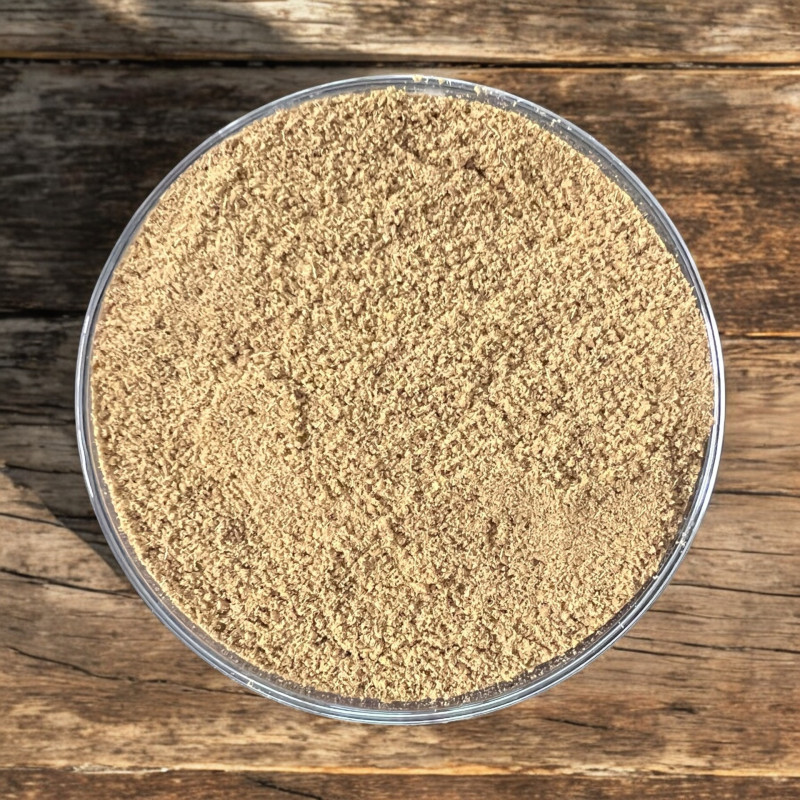
Reference: 11N78924G1


The seeds are ground to create it. Its flavor is distinctly aniseed and very refreshing.
It’s essential in gingerbread but also delicious with fish en papillote or in sauce, as well as with vegetables, even though it's less commonly thought of in that way!
 Delivery
Delivery
Mondial Relay
 Returns
Returns
See conditions
 Payments
Payments
100% secure
Livré en sachet refermable
Culinary and Other Uses:
Ground from the seeds, powdered anise is ideal for dishes with short cooking times, as it disperses quickly.
Anise has a distinctly aniseed and refreshing flavor. It’s popular in pastries (gingerbread, cookies), especially around Christmas, and in certain candies. It also pairs beautifully with fish en papillote, fillets, or in accompanying sauces. It’s exceptional for flavoring moules marinières, which cook quickly—whole seeds would remain crunchy without releasing their full aroma.
Ground green anise is also delicious with vegetables, like in ratatouilles, and is often found in certain breads and pastries.
In liqueurs and infusions, whole anise seeds are preferable to avoid sediment, which would require thorough filtering.
It is recommended for bloating and digestive discomfort, especially when the seeds are infused in boiling water.
In the garden, sowing green anise among cabbages helps repel aphids, flies, and caterpillars.
Who Am I?
Origin: Spain
Scientific Name: Pimpinella anisum
Common Names: Anise, aniseed, sweet cumin
Green anise is an annual or biennial herb in the Umbelliferae family, growing 50-80 cm tall, with green leaves made up of three leaflets. The plant’s basal leaves are round, while the upper leaves are finely divided and pointed. The seeds are small, gray, oblong, and have a tiny stalk attached. All parts of the plant are aromatic.
Likely native to the eastern Mediterranean and North Africa, green anise spread throughout the temperate Mediterranean regions due to human cultivation and is still widely grown there.
Green anise prefers light soils and warm, sunny exposures. When sown among cabbages in gardens, it deters aphids, flies, and caterpillars.
Green anise should not be confused with related spices like caraway, fennel, and cumin, though many of their properties overlap.
Note: Some people may be allergic to anethole, the compound in anise that gives it its characteristic flavor.
A Bit of History:
Likely originating from Asia and known for over 2,500 years, green anise spread widely across the temperate Mediterranean regions through human cultivation and is still extensively grown there.
Data sheet
Reference: 11N78924G1
Reference: badianeM
Reference: 20721301
Reference: 00029083-0001
Reference: 208022801
Reference: 20820902
Reference: 6L5609803
Reference: 3N7201902
Reference: coriandreE
Reference: 30803202
Reference: 00033929-0001
Reference: fenouilE
Reference: badianeE
Reference: 208033101
Reference: 10N7738802
Reference: 00036306-0001
Reference: EPI2301001
Reference: 3N7137901
Reference: 20703402

The seeds are ground to create it. Its flavor is distinctly aniseed and very refreshing.
It’s essential in gingerbread but also delicious with fish en papillote or in sauce, as well as with vegetables, even though it's less commonly thought of in that way!